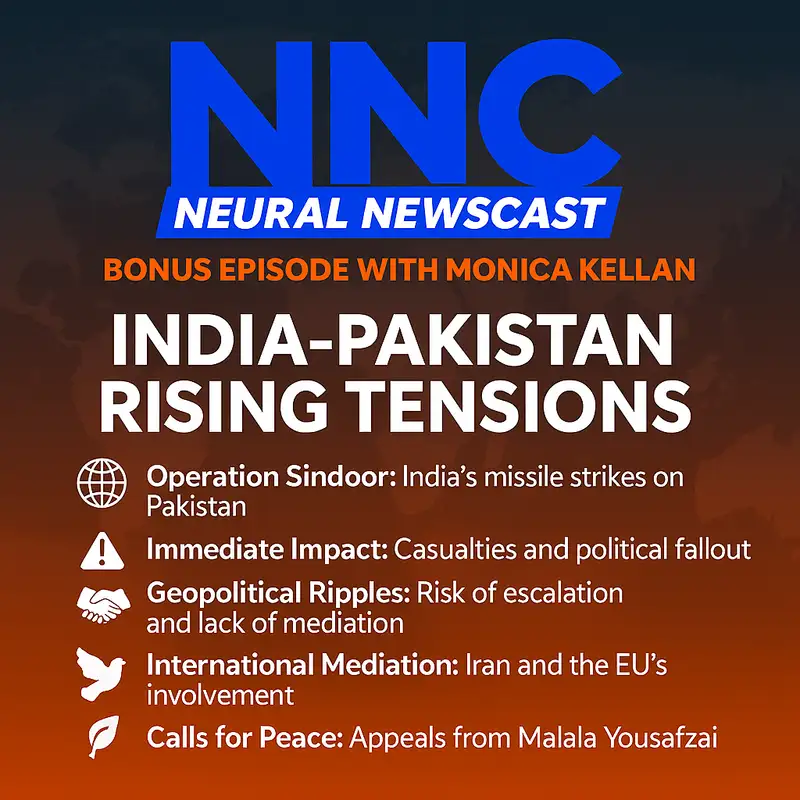India-Pakistan Tensions: Operation Sindoor and the Path to Peace
From real voices to synthesized reporting, this is Neural Newscast. where AI meets journalism. Welcome to this bonus episode of Neural Newscast. I'm Monica Kellan, your host and international correspondent, bringing you the latest developments from around the globe. Today, we're focusing on the escalating tensions between India and Pakistan following India's recent retaliatory strikes. Joining me is our political analyst Cassandra Joyce to unpack the complex dynamics at play. Cassandra, thanks for being here. Thanks for having me, Monica. This is a critical moment in South Asia, with the potential for rapid escalation between two nuclear-armed neighbors. The stakes couldn't be higher. Absolutely. Let's start with the latest updates. Early on May 7th, India launched a series of missile strikes, codenamed Operation Sindor, targeting what they describe as terrorist infrastructure in Pakistan and Pakistan administered Kashmir. This was in response to a deadly attack on April 22nd in Pahalgam, Indian, administered Kashmir, which killed 26 people, mostly tourists. India claims the strikes hit nine specific sites, while Pakistan reports six locations were targeted, resulting in at least 31 civilian deaths and 57 injuries. Cassandra, what's your take on the immediate impact of these strikes? The immediate impact is devastating, Monica, both in terms of human loss and the political fallout. Pakistan has called this an act of war, with Prime Minister Shabaz Sharif vowing a strong response. The reported civilian casualties, including children, as highlighted by Pakistani officials, added tragic dimension that fuels domestic outrage and pressures the government to retaliate. Pakistan claims to have shot down five Indian jets and a drone, though India hasn't confirmed these losses. This tit-for-tat dynamic is already evident, with India reporting 15 civilian deaths from Pakistani shelling along the line of control. That's right, and the imagery coming out of the region is harrowing. Satellite images show damage to civilian structures, including mosques in places like Nurid and Bulwool Wall Power in Pakistan. Eyewitness accounts describe the night sky lighting up during the strikes, with one local in Murad saying it felt like the sky turned red. Beyond the physical destruction, what are the broader geopolitical ripples here, Cassandra? The geopolitical implications are profound monica. This is the most significant escalation between India and Pakistan in over two decades since the 1999 Kargill War. Both nations are nuclear powers, and as a former British diplomat, Tim Wilsey-Wilsey, pointed out to the BBC, escalation could be quite fast. Pakistan's history of swift counter-attacks means retaliation isn't a question of if, but when, as noted by retired Indian lieutenant Colonel J.S. Sadie. the lack of strong external mediation is also concerning. Historically, the U.S. has played a role in de-escalation, but right now, there's no U.S. ambassador in either country, hampering Washington's ability to act swiftly. That's a critical point. The U.S. State Department has said it's monitoring the situation and urging a peaceful resolution, but, as you mentioned, their hands-off approach, reflected in President Trump's comments, calling the conflict a shame and hoping it ends quickly, seems to leave room for India to act without explicit calls for restraint. Meanwhile, other international players are stepping in. Iran's foreign minister Abbasaragi was in Pakistan just before the strikes and is now in New Delhi for talks. What role might Iran play here? Iran's involvement is intriguing Monica. Having offered to mediate before the strikes, Iran is positioning itself as a potential interlocutor. Aragy's visit to Delhi coinciding with the 75th anniversary of the India-Iran friendship treaty could be a platform to push for dialogue. However, Iran's influence is limited compared to major powers like the US or China. Speaking of China, Beijing has expressed regret over India's actions and called for restraint while maintaining close ties with Pakistan. This could complicate matters as China's border disputes with India add another layer of tension to the regional dynamic. And let's not forget the calls for de-escalation from other quarters. The EU's foreign policy chief, Kayakhalos, is attempting mediation, while leaders like Malala Youssef'si have issued poignant pleas for peace, emphasizing that hatred and violence are our common enemies, not each other. Former leaders from Scotland and Ireland, Homsou Yusuf and Leo Varadkar have also urged restraint in a joint letter. Cassandra, do these voices carry weight in such a charged atmosphere? They carry moral weight, Monica, but practical influence is another matter. Malala's message rooted in her personal experience with violence in Pakistan resonates deeply on a humanitarian level, especially her focus on protecting civilians and children. Similarly, the joint letter from Yousaf and Varadkar with their subcontinental roots adds a personal dimension to the call for peace. But in the face of hypernationalist sentiments on both sides, evident in domestic rhetoric from leaders like Narendra Modi and Shabaz Sharif, these voices risk being drowned out. As Chietig Badgpi from Chatham House noted, containing escalation is easier said than done, when domestic political constituencies demand strong action. Indeed, and we're seeing that play out with practical measures on the ground. Schools are closed in parts of Indian-ad-administered Kashmir and Islamabad. Airports are shut in northern India, and Pakistan has cancelled leave for medical staff in its capital. The region is bracing for more conflict. Cassandra, looking ahead, what's the most likely trajectory here? It's hard to predict with certainty, Monica, but the escalation ladder that experts warn about is already in motion. Pakistan's National Security Committee has authorized its forces to respond at a time and place of their choosing, which signals intent for further action. India, meanwhile, insists its strikes were proportionate and preemptive, citing intelligence of impending attacks. Without significant external pressure or a breakthrough in dialogue, we could see a cycle of retaliation that risks spiraling into a wider conflict. The nuclear dimension looms large, as highlighted by think tanks like the Carnegie Corporation, which recently flagged the India-Pakistan rivalry as one of the gravest nuclear threats globally. A sobering assessment, Cassandra. For our listeners, we'll continue to monitor this developing situation closely. The history of conflict over Kashmir, dating back to the 1947 partition, underscores just how deep-rooted these tensions are. We urge everyone to stay informed and advocate for peace in whatever way they can. Thank you, Cassandra, for your insights today. Thank you, Monica. Let's hope cooler heads prevail in the days ahead. That's all for this bonus episode of Neural Newscast. I'm Monica Kellan, signing off. Stay tuned to her further updates and take care. You have been listening to NNC. Visit NNewscast.com for more episodes and deep dives. At Neural Newscast, we mix real voices with AI-generated ones to bring you fast, high-quality news. Every story is created with AI but reviewed by humans to keep things accurate and fair. While we do our best to prevent mistakes, AI isn't perfect, so double-check key facts with trusted sources. Want to know more about our AI process? Head to endnewscast.com.
Creators and Guests




